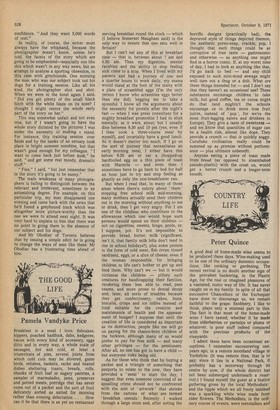COUNTRY LIFE Peter Quince
A good deal of home-made wine seems to be produced these days. Wine-making used to be one of the ordinary domestic occupations, like cooking or gardening. The recent revival is no doubt another sign of the prevalent hankering, in the Plastic Age, for the real or imagined pleasures of a vanished, rustic way of life. It has never caught on in my family. In spite of all that successive Chancellors of the Exchequer have done to discourage us, we remain faithful to the grape. Snobbery, I like to think, plays only a minimal part in this. The fact is that most of the home-made wine I have tasted, whether it be made from elderberries or parsnips or plums or whatever, is poor stuff indeed compared with the precious products of the vineyards.
I admit there have been occasional exceptions. I remember encountering one, years ago, in a remote moorland village in Yorkshire. (It was remote then, that is to say; since it lies in a National Park, it probably has a motorway through its centre by now, if the whole district has not been submerged underneath a reservoir.) I found myself the guest at a festive gathering given by the local Methodists : and the tipple which we all freely imbibed was a sparkling white wine made from elder flowers. The Methodists, in the ordinary course of events, were teetotallers and would never dream of going into the village pub for a pint of beer. I think they believed, or pretended to believe, that the elder-flower wine, being the product of their own virtuous farm kitchens, was non-alcoholic or at any rate so nearly so as not to matter. But it certainly wasn't. It was not only delicious but it also swiftly revealed itself as possessing a startling potency. The evening passed in a merry blur. I viewed my hosts, delightful people but hitherto considered decidedly staid, in a different light ever afterwards.
However, home-made wine does not often attain such heights. It is a pity, because a fruit like the elderberry, which at this moment hangs in thick, purple bunches on every hedge, looks as if nature intended it to make wine. We did once try to follow nature's apparent intentions in this respect. The elderberries certainly gave the wine an impressive and beautiful colour, but unfortunately that seemed to exhaust their capabilities. We ended up With several bottles of a thin and peculiarly nasty fluid. It smelt oddly and was overpoweringly sweet. Those who un derstand the mysteries of home winemaking tell me that the fault was ours, and I entirely accept the accusation. Nevertheless, the experience was discouraging. We have not, so far, been tempted to try again.
There is one traditional, home-made tipple which we do produce, however, with unfailing success and to the applause of all
Who are permitted to sample it. This is sloe gin. The virtue of this drink, apart
from its delectable character, is that its manufacture is simplicity itself, calling for none of the fidgety techiques and nice Judgements of wine-making. All you need is
a heap of sloes and a bottle of gin, plus a bit of brown sugar. You pierce the skins of
the sloes and drop them into the gin with the sugar; then you leave well alone for three months. At the end of that time you have a perfectly delicious liqueur. It is dark purple in colour and has a superb flavour. If you make it when the sloes are
ready to be picked from the hedgerows in the autumn, it will be ready to drink after Your Christmas dinner. Nothing could be easier, or more agreeable.
Picking the sloes is also a pleasant occupation on a sunny autumn afternoon. They are the fruits of the blackthorn, the Shrub which decorates the hedges with Masses of white blossom in the very early days of spring. Their dark, purple-black colour makes them almost invisible at first glance; it is quite easy to stare into a blackthorn for several minutes without Spotting a single fruit. Then one of them seems to materialise on a branch, then another, and gradually you come to see
them scattered about the bush. For some reason sloes fruit very sparingly in our
part of England; in other places, especially In North Wales, I have seen astonishingly heavy crops weighing down the spiky bushes. But in an hour or so the other day
I .filled a couple of pockets with the hard, bitter fruits, and they are now imparting a
luscious red tinge to a bottle of gin. I look forward to tasting the end-product on Christmas Day. I only wish I had a dozen bottles of that amazing elder-flower concoction to dispose of first.











































 Previous page
Previous page